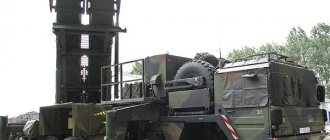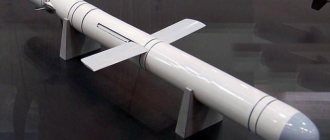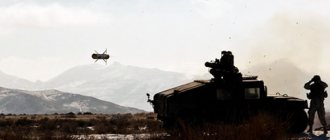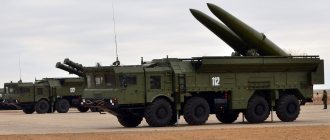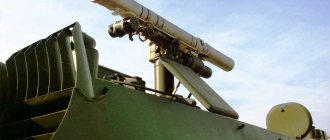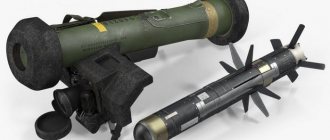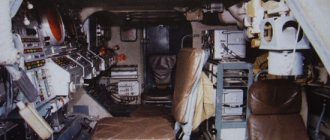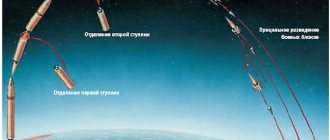With the advent of guided and homing medium- and long-range anti-aircraft weapons, the so-called “air supremacy” lost its original meaning. It has become impossible to launch missile and bomb attacks on ground forces with impunity. From the 50s of the last century to the present day, the modernization of old and the construction of new generation air defense missile systems has been continuously going on.
The most recent development of Russian designers was the S-500. The strictest secrecy surrounding everything connected with it does not provide answers to the questions that interest us. We have to be content with fragmentary publications.
History of the S-500
Work on the creation of a fifth-generation air defense system began in 2002 with an engineering note indicating the necessary parameters, and NPO Almaz decided on the initial appearance of the new weapon. From 2004 to 2006, the NGO conducted research under the code designations "Lord".
The next step was the appointment of the Almaz-Antey Air Defense Concern OJSC in 2006 as the main developer of the S-500 air defense system, and it turned out to be logical in 2008-2010 to continue scientific research under the themes known as “Vlastelin” and “Vlastelin-TP”.
In 2009, they tested the 40N6 missile and received a financial advance to begin work on the production of 77N6.1.R interceptor missiles. All details are strictly classified, but the press was notified of the start of the creation of the newest air defense system without any details.
The technical projects of the 55R6M and RK 98Zh6M1 air defense systems were completed in 2010 and the possibility of creating an air defense system with the specified parameters was finally confirmed.
At the same time, we were creating three-dimensional products 77T6, 77N6-N, 77N6-N1, debugging combat programs and engaged in mathematical modeling of missile defense control systems.
Anti-missiles 9M82, 9M82MD, 9M83, 9M728, 9M729, 77N6-N, MN-300, 53T6 were successfully tested in the summer of 2014. Indirect information about this event appeared two years later from the words of congratulations on the occasion of the 70th anniversary of the founding of the 4th MCMP (Kapustin Yar) from the general designer of the Novator Design Bureau P. Kamnev.
According to Deputy Minister of Defense Yu. Borisov, it became known about the task of building the first sample of the entire complex by 2020.
Taking the developments on the Triumph (S-400) air defense system as a basis, the designers created two basic versions of the air defense system:
- Triumfator-M;
- Triumphant-MR.
The construction of two new enterprises is planned. One will produce missiles, the other will produce ground parts of the complex.
Technical characteristics of the complex
The S-500 (the development characteristics are simply impressive) has a dry weight of 54 tons. The weight of the cargo in full combat readiness is 33 tons, and the tractor itself is 21 tons. The BAZ-69096 is equipped with five axles - all 10 wheels are driven. The front two axles are steerable. The power of the power unit is 550 horsepower. Fuel type – diesel. The maximum height of the curb to be overcome is 1.7 meters. The BAZ-69096 mobile chassis was first presented in 2012 at a show of Russian military equipment. This is the first mobile chassis for air defense systems, which has a 10 by 10 wheel arrangement.
The S-500 is an anti-aircraft missile system that has enormous potential and capabilities. Holders of the highest ranks of the Armed Forces of the Russian Federation share the same opinion. Since the system has not yet fully entered service, the remaining technical characteristics of the vehicle remain classified and are not subject to disclosure.
Purpose of the S-500 air defense system
As it became known, the deployed S-500 consists of two or three echelons. When built in three echelons, it is planned to use medium, long and ultra-long range missiles. And with two-echelon - only large and extra-large.
Regardless of separation, the system is designed to ensure interception and destruction of:
- existing small targets flying at speeds near and above sound, including all existing ICBMs;
- any other aerodynamic purposes, including the main part of aircraft in service with the NATO Air Force, including prototypes;
- AWACS type aircraft, including those protected by electronic warfare aircraft;
- artificial earth satellites (in the future).
S-500 weapons:
The 98Zh6M1 air defense system structurally includes radar guidance and illumination systems 76T6 and 77T6, various TPU (transport-launcher).
For the mobility of weapons, it is planned to use a chassis based on the BAZ-69096, AZ-6909-022, BAZ-6403.01 (tractor), BAZ-69092-012 or MZKT-792911. The rest will most likely be assembled on a chassis like MZKT-6922.
Main goals
The S-500, a fifth-generation missile system, performs 3 main tasks. These are:
- Protection.
- Interception.
- Destruction.
All these tasks are perfectly performed by the complex. Let's look at each of the points and determine what it is aimed at:
— The complex is protected from guidance and radio detection systems, as well as from modern systems that create interference for missiles and their guidance. Thus, the enemy will not be able to prevent the interception and destruction of his combat unit by any means. The developers paid special attention to this point.
— The S-500 system is capable of intercepting any flying objects at a distance of up to 3,500 kilometers. The maximum target interception altitude is 50 km. For comparison: the Patriot complex is capable of neutralizing a target at an altitude of up to 24 kilometers. Taking this indicator into account, we see that the Russian system is twice as good.
— The complex must be able to destroy the most modern air attack weapons. Our developers have managed to achieve incredible results. The S-500 air defense system is capable of shooting down low-orbit satellites, orbital platforms, hypersonic cruise missiles, aircraft and UAVs (over Mach 5).
S-500 and THAAD – which is better?
The THAAD (Terminal High Altitude Area Defense) long-range interception mobile anti-missile system created in the USA is very different from ours. So THAAD has only one type of missiles, designed to destroy both ballistic and aerodynamic targets.
“Omnivorousness” leads to deterioration in quality. An American anti-missile missile can shoot down a small target, such as a tactical missile with weapons of mass destruction, with a probability of only 15%, while the S-500 uses three types of missiles, one for each target. The largest has an interception range of 600 km, and TNAAD only 200 km.
The American AFAR radar “does not see” further than 1000 km, and the S-500 has two radars with guaranteed detection of any intruder at a distance of up to 2000 km.
The speed of the THAAD missile is about 1000 m/s. This is at least three times, but in practice it is much less than the development of the general designer A.G. Basistov. Unfortunately, the exact data is strictly classified. In addition, the 77N6-N and 77N6-N1 missiles are capable of hitting stealth combat units, which, after separation from the sustainer stage, have switched to self-control.
Another unpleasant surprise that THAAD does not have is its own electronic warfare system to neutralize anti-radar missiles, while the missiles of our complex received equipment to suppress enemy electronic warfare.
We are not even talking about the destruction of satellites by the TNAAD system, in contrast to the promising developments of missiles of the S-500 complex.
Apart from rumors and speculation, nothing is known about the development of the next generation of the S-1000 air defense system.
For a better understanding of what all air defense is, the image of a Russian nesting doll is suitable.
The largest is the S-500. Its younger brothers and sisters are “hidden” inside: S-400, S-300VM “Antey-2500”, ZRPK “Pantsir S-1”, “Buk-M3” and others.
Equipped with communications and electronic warfare equipment, possessing the latest missiles and interacting with aviation, such a powerful national aerospace defense reliably protects the skies of Russia.
Powerful protection
The main air shield of the state - this is how modern anti-aircraft missile systems can be briefly described. They are a collection of complex technical means and combat vehicles (objects) that are capable of preventing enemy aerospace attacks throughout almost the entire territory of the state. There are many different types of air defense systems, but the main one is the classification by theater of operations:
- Marine.
- Land.
The Russian Federation is a huge country with great capabilities; it will soon be armed with the S-500, an anti-aircraft missile system of the most modern type. She is capable of many things. The United States, as Russia’s main opponent, also has its own modern complexes, one of which is “Patriot”.
Today we will talk about how the S-500 missile system was created, what it is capable of, and also discuss recent tests. Let's start with the history of its appearance.
Foreign analogue – “Patriot”
Today in the world there are two almost equal air defense systems - those of the Russian Federation and those of the United States. In our country this is the S-400. The American development is called “Patriot-3”; it is the embodiment of perfection today. There is no better system than this. A modern anti-aircraft missile system is capable of destroying targets at an altitude of up to 24 kilometers and at a distance of up to 500 kilometers. The only drawback is the cross-country ability of this machine. Compared to Russian combat vehicles, the Patriot is not as powerful.
However, no one knows what the United States will do after the release of our S-500. Russia, having created a perfect system capable of destroying targets in space, is challenging the Americans. Will the US be able to respond? Time will show.
S-500 air defense system - summarizing data from open sources
Data on the S-500 anti-aircraft missile system, the first samples of which should appear in the army in 2022, are still extremely scarce. It is clear that the details are classified, however, the details allow us to draw conclusions. Let's try to summarize all the information available in open sources.
Creation of a fifth generation air defense system
For the first time they started talking about fifth-generation air defense systems fifteen years ago. In 2002-2003, information appeared that NPO Almaz was conducting an analysis of the necessary parameters for the development of air defense systems for the long term. Despite the paucity of information, it was from this time that some foreign military experts began to speculate on the topic of a new Russian air defense system.
At the end of 2003, it became known that work on the S-500 project at NPO Almaz entered the active phase, and in 2004, Almaz engineers began designing a new air defense system on scientific and applied topics with the code names “Vlastelin” and “ Autocrat". The main work on these topics was completed in 2005.
In 2006, field tests and refinements of the “Lord” and “Autocrat” projects were underway. All of them completed successfully. This radically changed the status of the design organization. At the end of 2006, the Military-Industrial Commission under the Government of the Russian Federation decided to transfer NPO Almaz to the status of the lead developer of a new generation air defense system, and in 2007 this was confirmed by relevant decrees.
In 2008, NPO Almaz was renamed into GSKB of the Almaz-Antey concern, defining the main direction - work on the topic “Vlastelin-TP”. At the same time, the first vague reports about the capabilities of the new S-500 complex appeared in the press. At the beginning of 2009, the development was officially announced. Moreover, it became known that the 40N6 missile for the S-500 complex is ready for testing.
In reality, by 2010, mock-ups of all systems had been prepared and the bulk of the design work had been completed. The Commander-in-Chief of the Space Forces, General O. Ostapenko, has repeatedly announced the testing of various elements of the promising system and the production of prototypes. Thus, by the end of 2022, the S-500 complex was theoretically ready for adoption...
Russian and foreign analysts agree that the S-500 is being created primarily to destroy objects in near space, that is, over 118 km from the Earth. At such altitudes, the air defense system can have three targets:
— blocks of intercontinental ballistic missiles (ICBMs) at the final stage of flight,
— combat orbital platforms (which are presumably being developed by the United States),
— satellites that are in orbits from 200 to 1000 km.
In addition, the S-500 is being developed to defeat all types of hypersonic lethal vehicles, including cruise and ballistic missiles. Three countries are actively working in this direction: Russia, the USA and China. So far only Russia has real results.
Establishing serial production of the S-500 air defense system
In 2012, the name of the new complex, the S-500 Prometheus air defense system, first appeared in the press, and discussions began on plans for its mass production. At that time, Almaz-Antey was busy producing various modifications of the S-300 and S-400 air defense systems and simply did not have the free capacity to implement such a large-scale and complex project as the S-500.
The construction of two plants at which the Almaz-Antey concern will produce new air defense systems, planned for 2015-2016, was largely completed in 2022. From this we can draw appropriate conclusions about the timing of the deployment of large-scale production of the S-500 complexes. (However, the production capacity of the Almaz-Antey concern made it possible to begin manufacturing prototypes of new air defense systems earlier).
Drawing and preliminary layout of the self-propelled launcher 77P6 of the promising S-500 Triumfator-M long-range air defense and missile defense system with long-range missiles (presumably of the 40N6 family). External differences are explained by the peculiarities of presenting classified information to the media and a wide audience
According to domestic military experts, the following development of events is most likely.
Before the completion of construction of the new ones, it will produce a pilot batch of S-500 complexes and begin testing and fine-tuning them. They will continue until the plants are put into operation, after which they will begin production of new air defense systems.
At the end of 2022, all preliminary work related to the organization of production of transport-loading and other mobile equipment for the S-500 Prometheus, the release of which is scheduled for 2018, was completed. “In the near future, a contract will be signed with the Start enterprise (Ekaterinburg) for transport vehicles, loading and roll-out systems,” said Igor Nasenkov, general director of the Technodinamika holding.
S-500 air defense system is ready for war at an altitude of 200 kilometers
The new complex will occupy the upper tier of Russia's layered air defense system. It will be able to engage targets at altitudes of about 200 kilometers. This means that the S-500 air defense system will be able to hit approaching enemy ballistic missiles at a range of 640-660 kilometers. The first regiment of new anti-aircraft missile systems will defend Moscow and central Russia.
The S-500 will be able to detect and simultaneously hit the warheads of ballistic missiles flying at speeds of up to seven kilometers per second. In addition, this system is equipped with interceptor missiles with an active radar homing head, which is its similarity with the Lockheed Martin THAAD (mobile ground-based anti-missile system for high-altitude transatmospheric interception of medium-range missiles).
According to some reports, the S500 Prometheus has already been created, the first samples are being secretly installed in combat positions, which will finally change the balance of nuclear forces between Russia and the United States. The Americans do not have missile defense systems capable of shooting down Russian carriers of Yars and Bulava nuclear warheads. Now there will be no means of delivering nuclear warheads that could penetrate Russia’s missile defense shield.
The S-500 will include a whole network of radars that provide interception and targeting at long distances. Thus, it will use the 91N6A(M) combat control radar, the modified 96L6-TsP target detection and acquisition radar, as well as the new 76T6 and 77T6 multi-mode anti-missile radars.
As one American military expert noted, although the Russian military-industrial complex suffered greatly as a result of the collapse of the Soviet Union, the Russians somehow, in an unimaginable way, managed to continue developing modern air defense systems. Moreover, some examples of these new systems are so advanced that even the F-22, F-35 and B-2 stealth aircraft have no way to overcome them...
When will the S-500 air defense system enter service with the troops?
In the spring of 2022, the Commander-in-Chief of the Aerospace Forces, Colonel General Viktor Bondarev, announced that the S-500 complex would enter service with the Russian air defense forces in the near future. It is known that the Zhukov Military Academy of Aerospace Defense has been training specialists to work on the S-500 for more than three years.
As for plans for mass production, from open sources we know about a plan for 10 divisions that will be produced before 2022. It is likely that production will continue after this period. The new S-500 will serve side by side with the S-400 for some time. The first batches of S-500 complexes can be manufactured with extensive use of the material and developments of the S-400 complex.
At the same time, the media periodically receives information that the production capabilities of the Almaz-Antey concern do not yet allow the production of full-fledged S-500s simultaneously with the already ordered S-400s.
S-500 air defense system as assessed by American experts
Recently, information appeared about the assessment of the complex by military engineers from the United States. They were amazed at its capabilities. They also made the assumption that at the presentation of the latest weapons, their combat characteristics were deliberately underestimated.
The specified height to hit the target is up to 97 kilometers. But experts from the famous American publication The National Interest, after studying the available materials, suspect that S-500 missiles are capable of hitting targets in near space at an altitude of up to 130 kilometers, including satellites. “Prometheus” is equipped with a unique device that at any altitude unmistakably distinguishes combat targets from decoys. At the same time, the S-500 can recognize and shoot down 10 enemy missiles at once.
In approximately two years, this complex will enter service with the Russian air defense unit. It is capable of destroying absolutely all air targets, regardless of their classification, speed and flight range.
So let's sum it up
The greatest possible threat to Russian nuclear forces at the moment is the American missile defense system, since intercontinental ballistic missiles are most vulnerable at the initial stage of their trajectory (visible on radar screens and have low speed). The S-500 air defense system will be capable of protecting domestic ICBMs immediately after launch, hitting enemy missile defenses with a kinetic strike.
The altitude for hitting targets with the S-500 will be about 200 km, which is quite enough to cover ICBMs and neutralize the anti-missile system. The S-500 complex will be able to receive target designation from various systems, including long-range radar detection aircraft.
The S-500 air defense system represents a new generation of anti-aircraft missile systems. The S-500 is not an upgrade of the existing S-400 system, it is a completely new development. The system will apply the principle of separate destruction of ballistic and aerodynamic targets. The S-500 and the S-400, S-300VM4, S-350 and other systems already in service with the troops will be connected into a single integrated air defense network.
S-500 - the newest air defense system in the Armed Forces of the Russian Federation
At the moment, two different anti-aircraft missile systems are guarding the country’s airspace - S-300 and S-400. The first, despite modifications, is already barely up to world standards. Soon after the S-500 enters service, the S-300 missile system will be removed from the ranks of Russian military equipment. Fourth and fifth generation systems will remain in service. Serial production of the latter is scheduled for 2022. The Ministry of Defense expects that the S-500 will become an insurmountable milestone in the development of air defense of other countries in the world for at least another two decades.
The Russian S-500 (anti-aircraft missile system) will be the best of all air defense systems. The Americans will continue to chase our technologies for a long time and try to get closer to the milestone set by domestic experts.
Testing of the latest air defense system
In the summer of 2014, the Russian Armed Forces tested a prototype of the S-500 air defense system.
According to preliminary data, it became known that the newest Russian air defense system has become the best in the world and has surpassed in its characteristics such complexes as Patriot-3 and THAAD. According to the Russian Ministry of Defense, the tests were carried out very successfully, all the goals and objectives were easily accomplished. The S-500, whose characteristics still remain unknown, has become the best of all existing advanced air defense systems. Based on the conclusion of the Ministry of Defense of the Russian Federation, we can conclude that our modern fifth-generation system, which will enter the army around mid-2017, will remain the best of its kind for at least 10-15 years.
